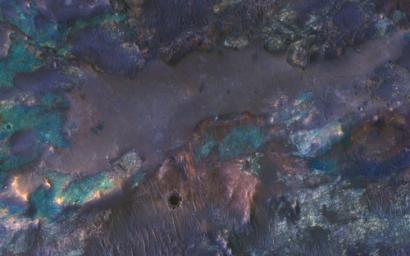
|
Colorful Impact Ejecta from Hargraves Crater
- Click the image above for a larger view
- Full-Res JPEG (2880 x 1800) (918.7 kB)
- Full-Res TIFF (2880 x 1800) (15.6 MB)
Caption:

Map Projected Browse Image
Click on the image for larger version
The collision that created Hargraves Crater impacted into diverse bedrock lithologies of ancient Mars. As a result, the impact ejecta is a rich mix of rock types with different colors and textures , as seen by NASA's Mars Reconnaissance Orbiter (MRO).
The crater is named after Robert Hargraves who discovered and studied meteorite impacts on the Earth.
This is a stereo pair with ESP_049963_2005 .
The map is projected here at a scale of 50 centimeters (19.7 inches) per pixel. [The original image scale is 59.2 centimeters (22.4 inches) per pixel (with 2 x 2 binning); objects on the order of 178 centimeters (33.8 inches) across are resolved.] North is up.
Background Info:
The University of Arizona, Tucson, operates HiRISE, which was built by Ball Aerospace & Technologies Corp., Boulder, Colo. NASA's Jet Propulsion Laboratory, a division of Caltech in Pasadena, California, manages the Mars Reconnaissance Orbiter Project for NASA's Science Mission Directorate, Washington.
Cataloging Keywords:
| Name | Value | Additional Values |
|---|---|---|
| Target | Mars | |
| System | ||
| Target Type | Planet | |
| Mission | Mars Reconnaissance Orbiter (MRO) | |
| Instrument Host | Mars Reconnaissance Orbiter | |
| Host Type | Orbiter | |
| Instrument | High Resolution Imaging Science Experiment (HiRISE) | |
| Detector | ||
| Extra Keywords | Collision, Color, Crater, Impact, Map | |
| Acquisition Date | ||
| Release Date | 2017-05-08 | |
| Date in Caption | ||
| Image Credit | NASA/JPL-Caltech/Univ. of Arizona | |
| Source | photojournal.jpl.nasa.gov/catalog/PIA21609 | |
| Identifier | PIA21609 | |
